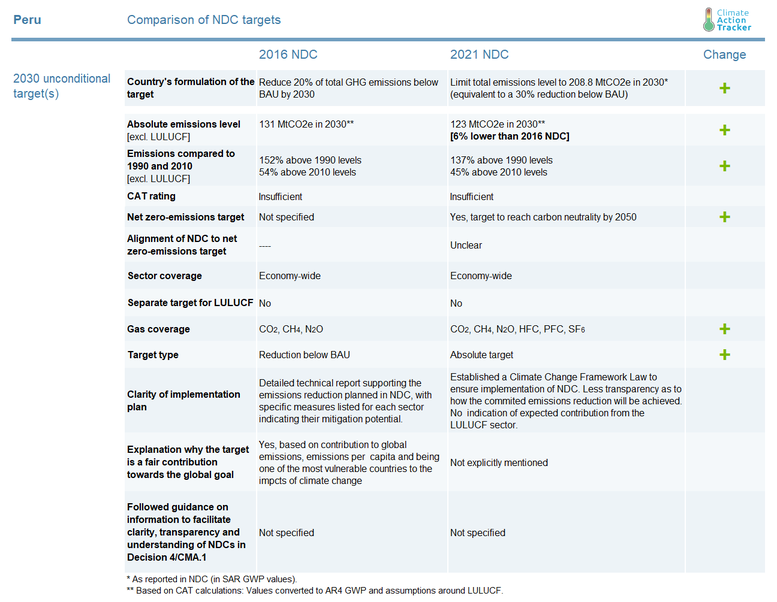Summary
Peru updated NDC, submitted in December 2020, slightly strengthens its 2030 target, rated “Insufficient.” The NDC represents an emissions level 6% lower than the previous one, but not enough to improve its rating. We continue to rate Peru’s mitigation commitment as Insufficient. However, the format of the target changed from a reduction below BAU to an absolute emissions reduction and the NDC now includes the goal to reach carbon neutrality by 2050.
We estimate the new target would be reached with the implementation of current policies, without the need for new additional policies. This highlights a missed opportunity for Peru to increase its climate action and set realistically achievable but ambitious targets that are aligned with the temperature goals of the Paris Agreement.
CAT analysis of the unconditional target


On December 18, 2020 Peru submitted an updated NDC to the UNFCCC that represents progress beyond its previous submission but that is still incompatible with limiting global warming to 2˚C above pre-industrial levels, let alone with the Paris Agreement’s 1.5°C limit.
With its new target, Peru commits to limiting emissions to about 123 MtCO2e (excl. LULUCF) by 2030, according to our calculations. This is an improvement compared to its first submission in two ways: it leads to 6% lower emissions levels by 2030 and it has changed its format from a reduction below BAU to an absolute emissions reduction target.
The submitted document, however, provides far fewer details than the previous NDC in terms of the expected emissions reduction contribution of each sector and, more importantly, of the LULUCF sector. In general, Peru should avoid relying on LULUCF sinks to achieve its climate targets as much as possible, given the high chance of carbon loss through deforestation or natural disturbance and eventual competition for land.
Peru’s new submission covers emissions from all sectors and six gases (CO2, CH4, N2O, HFCs, PFCs and SF6). The previous NDC covered only CO2, CH4 and N2O, for all sectors. The updated NDC also includes a section on adaptation commitments, similar to that in the first submission.
Additionally, the new NDC states that Peru will start the process to update its Climate Change National Strategy with a timeframe up to 2050. This update will be based on a Technical Study commissioned to explore pathways to reach carbon neutrality by 2050. Although Peru has stated its intention to reach net zero emissions by 2050, no further details have been communicated so far, which limits our ability to assess the expected contribution of the LULUCF sector to this target.
We estimate the new NDC target would be reached with the implementation of current policies, without the need for new additional policies. This highlights a missed opportunity for Peru to increase its climate action and set realistically achievable but ambitious targets that are aligned with the temperature goals of the Paris Agreement.
We rate Peru’s updated NDC as “Insufficient”. This rating has not changed compared to its first NDC and it means that Peru’s climate commitment in 2030 is not consistent with holding warming to below 2°C, let alone limiting it to 1.5°C as required under the Paris Agreement. Instead, Peru’s current ambition is consistent with warming between 2°C and 3°C. Peru’s climate commitment continues to be at the least stringent end of what would be a fair share of global effort, unless other countries make much deeper reductions and comparably greater efforts.
CAT analysis of the conditional NDC
Peru’s submission includes a conditional 2030 target which, according to our calculations, limits emissions to about 107 MtCO2e (excl. LULUCF) by 2030, conditional to access to international climate finance. This represents a step forward compared to the first submission, leading to an 8% lower emissions level by 2030 and increasing the target format’s strength from a reduction below BAU to an absolute emissions reduction target. Our rating of this conditional targets remains “Insufficient.” No further details have been provided for the conditional target (e.g., sectoral contributions to the target), making it difficult to assess.
Assumptions
LULUCF
The absolute emissions levels including LULUCF are provided directly in the NDC for the unconditional and conditional targets. To distinguish emissions reductions that are attributable to the LULUCF sector, the CAT assumes that the share of LULUCF mitigation efforts will be the same as it was in the first NDC submission, for both unconditional and conditional targets.
Global Warming Potential (GWP) values
The CAT uses Global Warming Potential (GWP) values from the IPCC's Fourth Assessment Report (AR4) for all its figures and time series. Peru’s NDC reports emissions levels in GWP of the Second Assessment Report (SAR). We converted these numbers to AR4 GWPs using an average conversion factor from SAR to AR4 based on the UNFCCC GHG inventory data registry, which includes granular information on all gases and sectors for key years.
Links
Stay informed
Subscribe to our newsletter

